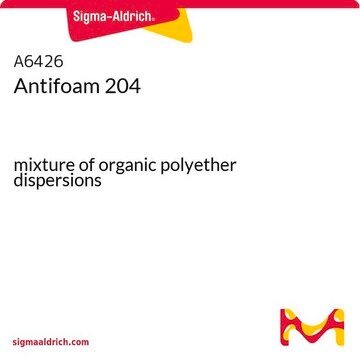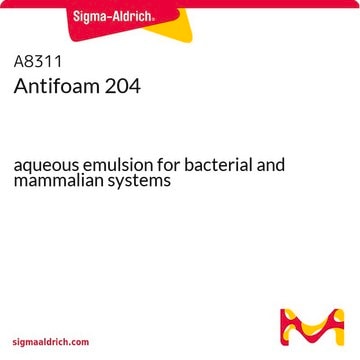Products may be shipped at a different temperature than the recommended long-term storage temperature. If the product quality is sensitive to short-term exposure to conditions other than the recommended long-term storage, it will be shipped on wet or dry-ice. If the product quality is NOT affected by short-term exposure to conditions other than the recommended long-term storage, it will be shipped at ambient temperature. As shipping routes are configured for minimum transit times, shipping at ambient temperature helps control shipping costs for our customers. For more information, please refer to the Storage and Transport Conditions document: https://www.sigmaaldrich.com/deepweb/assets/sigmaaldrich/marketing/global/documents/316/622/storage-transport-conditions-mk.pdf
81380
Polypropylene glycol
P 2,000
Synonym(s):
PPG
About This Item
Recommended Products
Quality Level
form
liquid
mol wt
Mn 1513
refractive index
n20/D 1.451
viscosity
~450 mPa.s(20 °C)
solubility
water: miscible (completely)
density
1.00 g/mL at 20 °C
SMILES string
O(C(CO)C)CC(O)C
InChI
1S/C6H14O3/c1-5(8)4-9-6(2)3-7/h5-8H,3-4H2,1-2H3
InChI key
DUFKCOQISQKSAV-UHFFFAOYSA-N
Looking for similar products? Visit Product Comparison Guide
General description
Application
It can be used in thepreparation of polyurethane(PU) elastomers. For example, it can be used tosynthesize PU elastomers with good acoustic absorption properties.
PPG-2000 can be used as a soft segment in the preparationof PU-based self-healing polymeric networks. These networks find application in the field of soft electronics.
Features and Benefits
- Long and flexible alkyl groups promotechain mobility, which facilitates rapid self-healing.
- The methyl groups present on the sides of thepolymer improve emulsification in water.
Storage Class Code
10 - Combustible liquids
WGK
WGK 1
Flash Point(F)
445.0 °F - closed cup
Flash Point(C)
229.44 °C - closed cup
Personal Protective Equipment
Choose from one of the most recent versions:
Already Own This Product?
Find documentation for the products that you have recently purchased in the Document Library.
Customers Also Viewed
-
How is shipping temperature determined? And how is it related to the product storage temperature?
1 answer-
Helpful?
-
-
How can I determine the shelf life / expiration / retest date of this product?
1 answer-
If this product has an expiration or retest date, it will be shown on the Certificate of Analysis (COA, CofA). If there is no retest or expiration date listed on the product's COA, we do not have suitable stability data to determine a shelf life. For these products, the only date on the COA will be the release date; a retest, expiration, or use-by-date will not be displayed.
For all products, we recommend handling per defined conditions as printed in our product literature and website product descriptions. We recommend that products should be routinely inspected by customers to ensure they perform as expected.
For products without retest or expiration dates, our standard warranty of 1 year from the date of shipment is applicable.
For more information, please refer to the Product Dating Information document: https://www.sigmaaldrich.com/deepweb/assets/sigmaaldrich/marketing/global/documents/449/386/product-dating-information-mk.pdfHelpful?
-
-
Is the item monodispersed Polypropylene glycol?
1 answer-
This product is tested for Mn and Mw. The polydispersity index (PDI) can be calculated by dividing Mw by Mn. A value of 1 would indicate a monodisperse polymer. For a recent lot (sample COA: https://www.sigmaaldrich.com/certificates/sapfs/PROD/sap/certificate_pdfs/COFA/Q14/81380-BULKBCCK6778.pdf), the Mw was tested to be 3116 and the Mw was tested to be 3009, equating to a PDI of 1.04, which is very close to being considered monodisperse. The Mw and Mn values do not have specifications associated with them but, historically, they tend to be similar to each other for this polymer.
Helpful?
-
-
Can this be autoclaved? If not, what is the recommend method to sterilize it?
1 answer-
Yes, this product is autoclavable.
Helpful?
-
-
How much water is in this product?
1 answer-
The specification for water content is ≤ 0.1 %. The exact amount will be listed on the lot-specific Certificate of Analysis. Please see the sample Certificate of Analysis: https://www.sigmaaldrich.com/certificates/sapfs/PROD/sap/certificate_pdfs/COFA/Q14/81380-BULKBCCH4979.pdf.
Helpful?
-
Active Filters
Our team of scientists has experience in all areas of research including Life Science, Material Science, Chemical Synthesis, Chromatography, Analytical and many others.
Contact Technical Service






